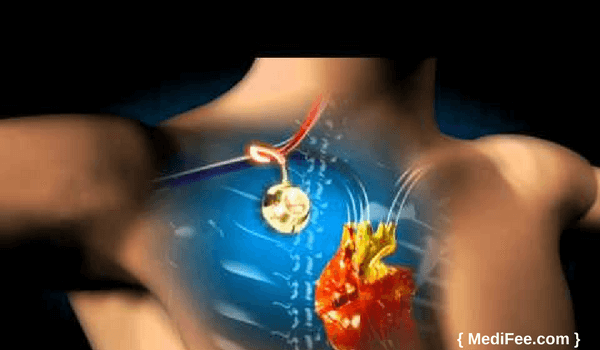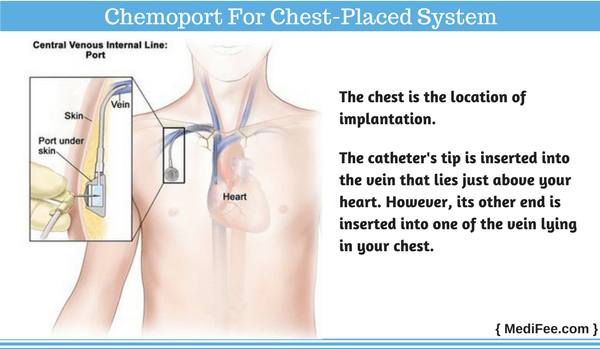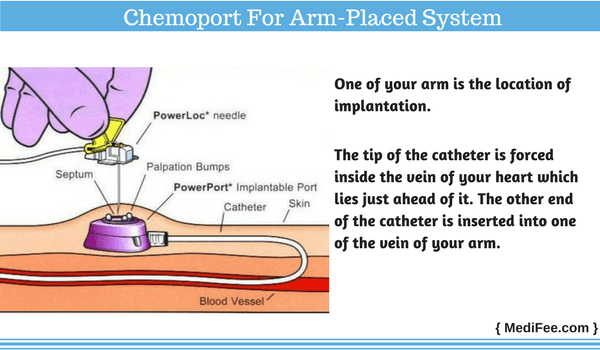Chemoport
Listed below is the step by step procedure of chemoport insertion:
- What is Chemoport?
- Why is Chemoport Required?
- Pre-operative Preparation
- Procedure Day
- Methods/Techniques of Chemoport
- Post Procedure
- Risks and Complications
What is Chemoport ?
A chemoport is an intra-dermal or sub-dermal line or access point made on the chest or arm of patients to assist intravenous (IV) chemotherapy. Chemoport involves placing a device under your skin that gives vascular access for IV therapies and injecting contrast materials for scanning tests. This placement provides easy access to your blood stream.

A chemoport is also termed as mediport, cancer port or port-a-cath. Based on the patient's requirements and need, your doctor can use different types of chemoports. These types of chemoports vary in their length and treatment type.
The various types of chemoports are as follows:
- Tunneled Central Venous Catheter: As the name suggests, the central venous catheter is placed under the skin of your chest and connected to the central vein using a surgical procedure. The outer part of this port contains a catheter that hangs outside your skin. This catheter has multiple openings. It is placed under your skin for several months.
- Intra-peritoneal Port: This port too contains a form of catheter known as Tenckhoff catheter. This catheter is placed under the skin of your abdomen.
- Implantable Venous Access Point: This port is also referred to as medi-port or Port-a-Cath. It is made up of stainless steel, plastic or titanium. A venous access point is a drum shaped device. It is either placed under the skin of your chest or upper arm. It contains a catheter tube attached to the device that connects the central vein.
- PICC Line: The Peripherally Inserted Central Catheter (PICC) line is made up of a plastic material. It is a temporarily used device that looks like a catheter. It is connected to one of the larger veins of your upper arm.
Why is Chemoport Required?
The main reason of implanting a chemoport is to administer chemotherapy drugs into the patient's blood.
If your chemo therapy is combined with radiotherapy (radiation therapy), double or multiple chemoports can be used for both the purposes, i.e., injecting chemo drugs as well as contrast substance.
Various types of chemoports serve various requirements for cancer patients.
- Tunneled central venous catheter is used to fill in the medicines of chemotherapy through the external pipe (catheter) that directly connects to the central vein of your chest.
- Intra-peritoneal point is required for an advanced type of chemotherapy (also referred to as intra-peritoneal chemotherapy) to treat stomach cancer.
- Implanted venous access point is required for long term chemotherapy process. A non-coring syringe is used to inject chemo drugs through your skin into the catheter tube. A non-coring syringe is specially designed at its tip to allow more resilience compared to the ordinary ones.
- PICC line is usually required if your chemotherapy treatment is of a short duration containing short infusions of chemo drugs.
Chemoport can be implanted as it contains the following benefits:
- Chemoports lower the risks of damage caused to your muscles and tissues.
- It provides multiple access to the veins of your body in order to conduct various types of cancer treatments at the same period of time. Double or multiple ports can be used for simultaneous treatments.
- Chemoports allow your oncologist to frequently collect blood samples of cancer patients without injecting a needle each time. Blood samples are collected through the catheter.
- Chemoports prevent the risks of bleeding. This adds as a plus point to cancer patients who have low platelet count.
- Implanting a chemoport is a very effective method to infuse chemotherapy drugs periodically at the patient's home.
Pre-operative Preparations
Preoperative preparations consist of various steps that are important before implanting a chemoport device. Some aspects of your system can cause a bad influence on the chemoport implantation process. Therefore, it is necessary to make proper arrangements before placing a chemoport inside your body.
- Blood Tests
Your doctor will carry out some blood tests in order to determine levels of hemoglobin, white blood cells, blood sugar and blood clotting time. Presence of infections within your body can also be verified using these blood tests. If any of the above abnormal conditions occur within your body, your doctor needs to delay the process of chemoport implantation. First, he/she will treat these health disorders and then proceed with the implants.
- Physical Examination
It is mandatory to conduct a routine physical checkup before the placement of chemoports. This check-up includes monitoring your physical health condition as well as learning about your medical history.
- Medications
Discuss about all the types of medications you intake on a regular basis. If you consume anti-platelet medications, for example, aspirin, or blood thinning drugs like warfarin, you may be asked to discontinue them for some short period of time until the placement of chemoports. Although, patients who have coronary stems or metallic heart valves cannot discontinue the intake of these medicines even if it is asked for a short duration. For such individuals, oncologists use an alternative method to deal with this issue.
- Deciding Type of Chemoport
Based on your medical history and other health conditions, doctor will decide the best type of chemoport to use for your case of cancer. As mentioned earlier, an intra-peritoneal port is usually used for abdominal cancer patients. Likewise, other types of chemoports can be used based on your health requirements and duration of your chemotherapy. He/she will also decide about the location of implant, i.e., to connect these ports to the veins of your arm or chest.
Your doctor will educate you entirely about the procedure of chemoport fixation. He/she will also mention benefits and risks of this procedure. You are advised to follow all the preoperative instructions before you undergo this implantation. The most important instruction is regarding food and water intake. Patients should avoid eating or drinking any kind of food items for at-least six hours before the fixation process. However, you can drink water two hours before your surgery begins.
Other requisites of preoperative care include time schedule of the implantation process. This schedule mostly depends on what type of chemotherapy one is undergoing. Some patients may require a short infusion whereas some can undergo chemotherapy for longer duration of time. Time of your chemotherapy is dependent on the type, extent, stage and other aspects of your cancer disease as well as the size of your body. Patients will be explained about all these points as well.Procedure Day
Patients are advised to arrive 30 minutes earlier on the procedure day. Team of nurses and doctors will make necessary arrangements for chemoport implant. You will be taken to the surgical room. Initially your vitals will be monitored by nurses, that includes checking your blood pressure and glucose levels. Doctor/nurse will create an intravenous (IV) line around your arm.
Chemoport placement procedure is performed under the influence of local anesthesia. Doctor will inject anesthesia on either your arm or chest or abdominal region which mainly depends on the location where your chemoport implant is being placed. Anesthesia is administered using the intravenous lines into this location.
Methods/Techniques of Chemoport
The procedure begins by making a cut on your skin which is about 3 cm in length. Also, a 5 mm incision is made at the lower region of your neck to get access to your vein. A port is implanted entirely within your body. A catheter is passed to this port and its other end is surgically inserted into one of the vein.
The frontal side of the catheter contains a tube to carry chemotherapy drugs to the internal parts of your body and a cap at the end that provides a point of input to infuse these drugs. This part of the catheter acts as a portal which is left hanging outside your body. The position of the port placement is confirmed using a fluroscopy, a type of X-ray. It takes around 60 minutes for implementing the complete procedure of chemoport implantation.
- For a chest-placed system: The chest is the location of implantation. Here, the port is placed under the skin of your chest. The catheter's tip is inserted into the vein that lies just above your heart. However, its other end is inserted into one of the vein lying in your chest.

- For an arm-placed system: One of your arm is the location of implantation. The port is placed under the skin of your chest. The tip of the catheter is forced inside the vein of your heart which lies just ahead of it. The other end of the catheter is inserted into one of the vein of your arm.

Removal of Chemoport
The removal process of chemoport is much easier and less painful compared to its placement process. The patient is given local anesthesia to numb the area before starting with the removal of chemoport. Initially your surgeon applies an anti-itch cream around your surgical areas. He/she then makes a small incision to surgically remove the catheter from your artery. He/she then puts some pressure for minimum of 7 minutes on that area to prevent further bleeding. The next step involves discarding the port from where it was fixed. This is done by cutting the sutures to remove the fittings. A similar pressure is applied to this area as well to ensure that the bleeding stops. After successful removal of the entire device, your surgeon sutures the inner and outer incisions by dissolving stitches. The entire chemoport removal procedure requires nearly about 30 minutes.
Post Procedure
For Port Implantation
A port placement surgery is an out patient procedure. Therefore, after the surgery, you will be taken to the general room to rest until the influence of anesthesia wears off. A physical routine check up will be conducted for you to ensure whether everything is fine. Any unnecessary health condition may call for corresponding treatment.
Your doctor will prescribe antibiotics and pain killers to provide relief from the pain and other problems causing out of this process. Along with the medications, he/she will also instruct you about the time you must consume these medications.
One of the most important step to follow during your post operative care is to maintain the hygiene around your implanted region. Make sure your keep the area of port clean every time before as well as after the chemotherapy process.
The needle that gives access for infusion of chemotherapy drugs is usually covered with a cotton dressing to keep that site clean. The cotton dressing also help to maintain the needle in place. If a needle is not placed around your portals, one can take shower regularly.
You can experience slight redness and tenderness around your surgical areas. However, it goes away within 24 hours to 48 hours after the surgery. Other issues like swelling and bleeding or drainage can also be seen from those areas. If these issues stay for more than 3 days, consult your doctor immediately. One can also experience unusual changes on their skin that have had an incision. Let your doctor know about all these abnormal changes.
Make sure you keep changing your cotton dressing after some days. If your port was unused for more than seven days after the placement procedure, visit your doctor to ensure whether there is any wound condition occurring. Also, if the gap between each chemotherapy session is too long, take a follow up with your doctor every four weeks. These follow ups are conducted in order to clean your portals. Saline water is used to flush all the catheter tubes. They are then refilled with heparinized (adding a drug called heparin) saline to avoid blood from clotting in those areas.
Your doctor will suggest you about the instructions and precautions to follow in the post procedure phase. You must avoid rigorous activities that include your arms or chest for minimum ten days at-least. Reduce activities that include excessive movement of your upper arm and chest repetitively. For example, swimming, lifting heavy objects, playing cricket (especially batting and bowling movements), exercising, etc. Performing such activities could possibly damage or break the catheter placed inside your body.
Avoid excess consumption of fluid when you have a catheter placed inside your body. Failing to do so can block the catheter tubes. Ensure there is minimum contact with the catheter tube hanging outside your body to avoid the risk of infections. Also, close the cap of the catheter tube tight enough to avoid any air from entering into your body, especially your veins. Avoid the catheter tubes to develop any scratch or breakage.
For Port Removal
After removal of the chemoport, you are advised to rest for at-least three days until you totally recover. The areas of incision can be swollen during this period. They can also bleed for few hours. Your doctor will apply certain ointments in those regions where incisions were made. It can also be covered with a cotton dressing to avoid bleeding and infection.
Doctor will prescribe you with pain-relief medicines if need be. It is advisable to avoid strenuous activities for few days until you recover totally. If you experience any abnormal situation during this period, visit your doctor immediately.
Avoid sleeping on your chest. This can loosen up your stitches and can cause areas of incision to bleed. It also puts a pressure on your surgical section.
Risks and Complications
After Chemoport Implant
The following risks and complications are likely to occur after implanting a chemoport:
- Infections: Infection is a common issue that occurs out of most surgeries. If bacteria enters any section of your catheter tubes, it can also lead to severe infections. Therefore, it is very important to maintain hygiene of those external tubes. Also, undergo the cleaning process of your internal catheter tubes. However, if any infections occur, they can be managed using antibiotics.
- Occlusion: Blood vessels around your portals can undergo blockages. Some blood vessels may also get closed due to blood clots.
- Air leakage: During the implantation process of chemoport, air could leak out from your lungs. Although, this problem is resolved after some time.
- Skin blisters: There can be an occurrence of fictional motion of the port while chemotherapy is performed. This creates irritation and itching around the skin. It can also lead to formation of skin blisters. Other reason for skin blisters can be because of irritating chemicals or intensely cold or warm substance.
- Extrusion: This is a very rare kind of risk. If the subcutaneous section of the port erodes out of the skin, it can be troublesome. This mainly happens in severely weak patients.
- Mal-positioning: If the implanted port gets dislodged from its original point, it makes it difficult for your doctor to get proper access for chemotherapy procedure.
- Internal bleeding: There can be a possibility of bleeding from your blood vessels.
- Pain and discomfort: It is very common to experience pain and slight discomfort around your chest or arms when you have implanted a chemoport under your skin.
- Other damages: Your blood vessels may get damaged or experience bruising. During port insertion, your lungs could get punctured. Therefore, patient's body is monitored efficiently once the placement procedure is complete.
After Chemoport Removal
Mentioned below is a list of common risks and complication that may occur after the removal of chemoport.
- Infections: The site of incision can develop infections due to various reasons. However, one can take antibiotics to get rid of such situations.
- Port fracture: The chemoport device could get fractured during the removal process.
- Pain: You can experience slight pain around your incision areas for few hours. However, it gradually reduces and goes away as your internal and external wounds heal.

